Outdoor living room ideas – 15 ways to create the most stylish and serene space to unwind
These outdoor living room ideas will help you create the garden lounging spot that you’ve always dreamed of
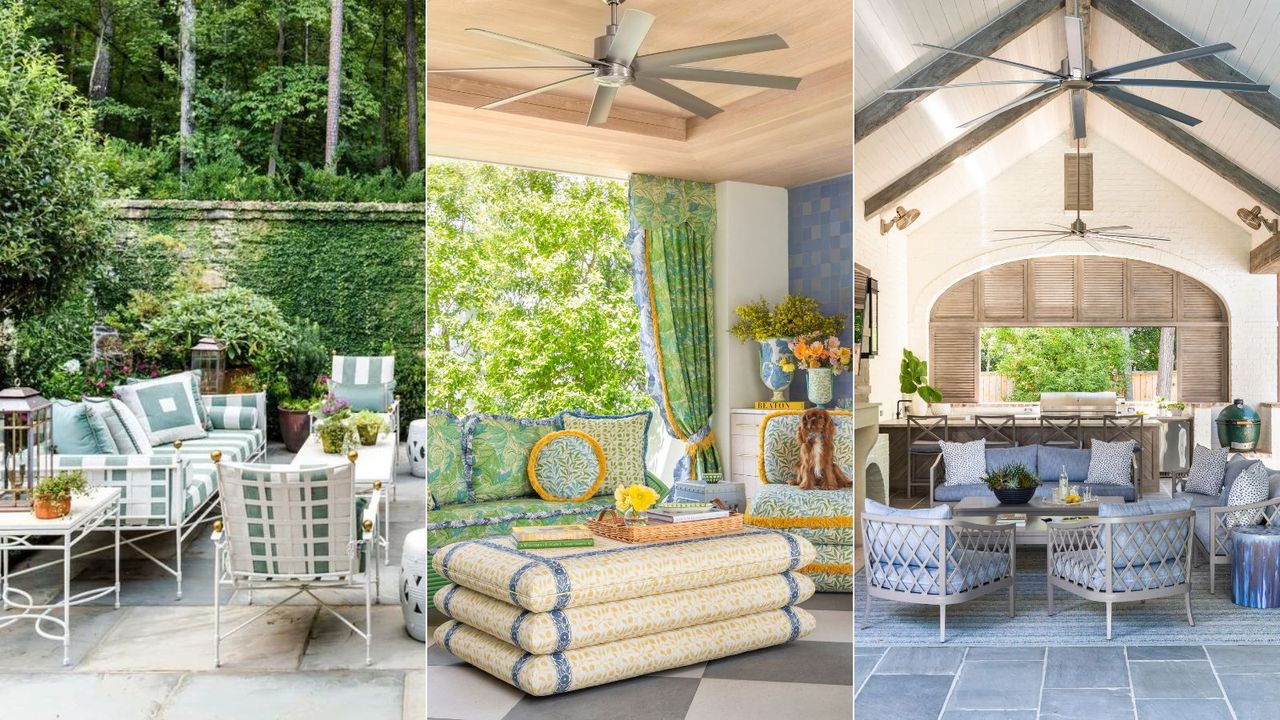
- 1. First, consider how you want to use your outdoor living room
- 2. Find the perfect spot
- 3. Create a seamless indoor/outdoor feel
- 5. Consider color and design style
- 6. Use plants to define the space
- 7. Plan from the floor up
- 8. Provide shelter
- 9. Keep things as private possible
- 10. Select high-performance, weather-proof fabrics and furniture
- 11. Focus on lighting for ambiance
- 12. Create areas designed for entertainment
- 14. Provide a connection to your outdoor kitchen
- 15. Finally, up the style stakes with accessories and decor
- FAQs

An outdoor living room can significantly enhance the enjoyment of your home by transforming your backyard into an extension of your home. All it takes is a little planning, design know-how, and expert advice.
Nowadays we want to use our outdoor living space year-round and every day, if the weather allows, for relaxing, entertaining, and hosting family gatherings. ‘Your garden should always be thought of as an extension of your home, so it’s important to bring the comfort of indoors outside. One way to do this is to divide your outdoor space up by ‘rooms’, with one area for dining and another for relaxing,' says OKA’s co-founder and creative director, Sue Jones.
Whether you’re looking to create the ideal lounging spot, an extension to your outdoor kitchen ideas, or you want to add living space by creating a garden room, start by dividing what you have into zones and update the garden furniture. Then, consult these 15 expert-led outdoor living room ideas to create a stylish and serene space.
15 Unique Outdoor Living Room Ideas

To make the most of this ‘extra room’, we must think creatively about how to plan, design and decorate. An outdoor living area should offer all the comforts and style of an indoor living room but also be designed with the weather, privacy and surrounding features such as patios, planting and lawns in mind.
Any change, big or small, can be transformative, so we asked the experts to share their backyard ideas, insider tips, and advice on where to start.
1. First, consider how you want to use your outdoor living room

Whether you want to level up your outdoor dining ideas or you're designing an outdoor living room simply just for relaxing, it’s important to consider what you want the space to offer you.
Is it to be an oasis? A social hub? A cooking or dining space? Created as a relaxing retreat, this area utilizes tall, layered planting and a fireplace chimney to help shut out the rest of the world.
‘The idea was to create a space to get away from all of the external activity,’ says interior designer Tim Clarke who designed this space seen above. ‘With its fireplace and lush planting, including palms to sit under, a true escape was created.’
2. Find the perfect spot

Where and how you plan your outdoor living area will be dominated by surrounding structures and features that you may wish to retain, such as specimen trees, pools and water features, and existing patios and terraced areas.
Consider the ease of use and access; does it feel ‘natural’ to walk towards the outdoor living area, or would you need additional pathways or steps? Would the outdoor living area be orientated to maximize how the sun rises and falls? Many people like their outdoor living area to face west so they can sit and watch the sun go down.
And is there enough space – or too much – to make the outdoor living space comfortable to relax in? Whilst there are solutions for tight spots, it can be difficult to bring together a larger space effectively, so you may have to figure out how to bring in items such as planters, screening, and shelter to help the area feel less open to the elements.
3. Create a seamless indoor/outdoor feel

Most outdoor living areas will lead directly from the house into the garden or yard. So it's important to create a strong connection between both spaces, or you will end up with a disjointed look. The easiest way to achieve this is with confident use of color.
Take your first cue from the dominant shades and styles in the connecting indoor room and echo these outside. 'People want to see a flow from their interiors to their exteriors, and the best way to achieve this seamlessness is through creating an aesthetic that you can carry through both spaces,' says Jonny Brierley, CEO of outdoor furniture company, Moda Furnishings.
A stand-alone outdoor living area, meanwhile, adds another dimension. 'I always like to include a sitting area in a secluded spot. It really makes the space your private paradise,' says Susan Spath, president of luxury furnishings company Kern & Company and principal designer of Susan Spath Interior Design. 'I love adding classic French style to these areas by incorporating an antique stone bench or antique stone bird bath.'
4. Prioritze comfort

There is so much choice, from low-slung corner sofas to hanging egg-chairs and suspended swing seats, making choosing furniture for your outdoor living space a minefield.
Above all, choosing furniture for your outdoor space is all about creating the most comfortable relaxing environment for your family and friends to enjoy in all types of occasions. Think very specifically and hone down exactly what will work best for your needs.
Comfort and durability are key when designing an outdoor living room,' says Michelle Morgan Harrison of Morgan Harrison Home. 'You want to make sure there’s ample seating as well as the typical conveniences of the indoors - like side tables and coffee tables. Durable, weather-resistant materials are a must and we typically like to keep the palette simple [see above] including soft blues or beiges, which seamlessly flow into the hues of nature.'
Be sure to measure your available space and then think about how many people will use the furniture and what kind of seating and tables will suit best. Furniture, with moveable stools and chairs that can be added or taken away to create seating around a table or a lounging bed are always a good idea.
5. Consider color and design style

'I love to continue the color story and general feel of a home’s indoor spaces into the outdoors so that an outdoor living room is really an extension of the home inside,' says Courtnay Tartt Elias of Creative Tonic Design and creator of the playful space seen above.
'Outdoor sofas of similar shape to those indoors clad in high-performance fabric and dotted with throw pillows, using outdoor lighting with similar finishes and lines as those indoors, and even continuing the same flooring, when possible, allow the outdoor space to flow easily from the indoors,' she advises.
For a successful overall look, you need to be disciplined about what to include and leave out of a carefully curated outdoor space. But you can choose flexible cushions and accessories to switch up the look with the seasons and as trends change.
'We look to incorporate colors or textures found in the interior into the outdoor space for visual continuity between the indoor and outdoor areas,' adds Denise Morrison of Morrison Interiors. 'We also look at colors incorporated into the landscape and overall architecture that we can reinterpret into the outdoor space in a fresh way.'
6. Use plants to define the space
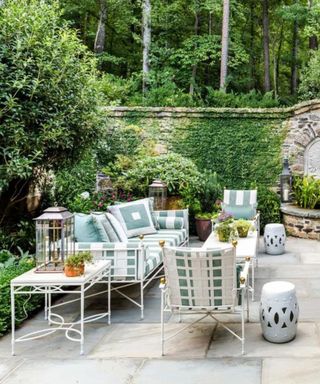
Plants give an outdoor seating area life – adding color, texture, and fragrance which will help your scheme to settle happily into its background or landscape. Whilst bringing in planters of exotic palms and creating raised beds of fragrant herbs creates a wonderful ambiance, before you start to plan, consider what you have already.
This approach will help your outdoor living area to feel totally natural and in place. 'Before you remove established shrubs and trees from your planned outdoor living area, think about how you can work the layout around them, making the most of the green structure and natural framework they provide,' says garden designer, owner of Lucy Conochie Design. 'It may mean choosing a different sofa set or laying a smaller patio, but the visual and wellbeing benefits provided by an established canopy of foliage will more than outweigh this.'
7. Plan from the floor up
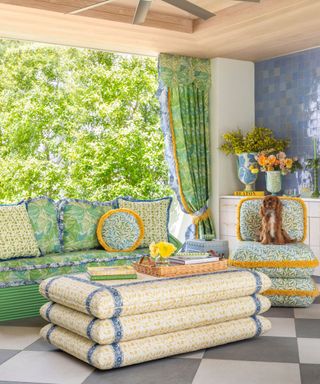
When you’ve settled on your perfect spot and color scheme, plan your outdoor living space from the floor up. Whatever outdoor furniture you choose, shades you select and plants you bring in, for a coherent whole, everything must work from the bottom up.
If your outdoor space is ultra-modern, with lots of metallic finishes and strong contrasts, high-gloss floor porcelain floor tiles could look amazingly chic.
However, for most other outdoor living looks, natural is a fail-safe choice; stone paving or timber decking (hardwood is more durable), being favorites. 'Both gravel and cobble-stone are very adaptable natural choices and they sit well with a number of different garden ideas,' says Susan Spath. 'I like to use gravel and cobble-stone to bring in character. When you mix them together with 24in x 24in pavers (whatever stone it might be) and grass, it adds a different perspective and creates conversation.'
8. Provide shelter
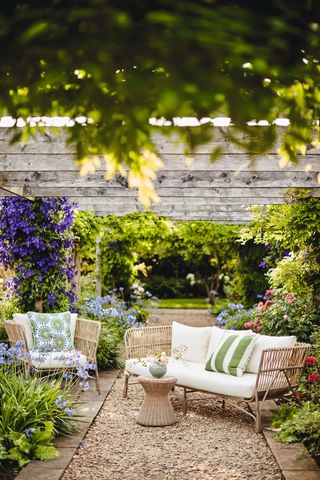
A pergola, gazebo, awning, sail, porch, or overhang from an existing building will provide protection from strong sunlight, extreme temperatures, wind, and the occasional shower of rain.
This can make an amazing impact as a design feature in its own right, or become the centerpiece of an established planting scheme. Visually stunning plants to train up and over freestanding shelters include fragrant wisteria, roses, and in a sheltered spot, clematis or passionflower. If climate conditions are right, a grapevine weaving its way through a pergola can be a wonderful addition to any outside space.
If your yard is overlooked by neighbors, adding a ‘roof’ will bring privacy as you won’t be looked down upon by those above. This will enhance the feeling that your outside space is a room to be enjoyed just as much as you would indoors. Arranged underneath a pergola covered in flowering climbers, a sofa set is an idyllic place to spend lazy afternoons surrounded by nature, or it could be positioned on a patio and used for entertaining guests on a summer evening.
9. Keep things as private possible
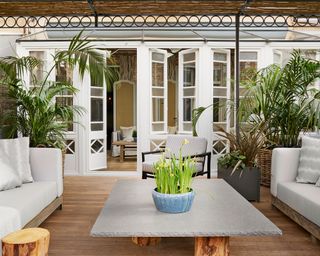
You want your outdoor living space to feel as private as your indoor living room, but that isn’t always easy, especially if you live in city and your yard is overlooked.
The key is to create effective screening to erect a barrier between your garden and the outside world. This can be achieved with garden fence ideas, with horizontal slats looking smart and allowing winds to penetrate safely. Other options include metalwork or fretwork screens, outdoor curtains in muslin or calico and planting.
If a fence is not possible, or you’re still left exposed, section off a specific outdoor living area by creating a frame, which you can then fill in with garden screening ideas, or grouping of plants with large leaves such as Canna Musifolia (paddle-shaped leaves and exotic flowers, a banana palm or a dramatic fatsia, suggests Sophie Birkert, lead designer and founder of garden company Screen With Envy.
10. Select high-performance, weather-proof fabrics and furniture
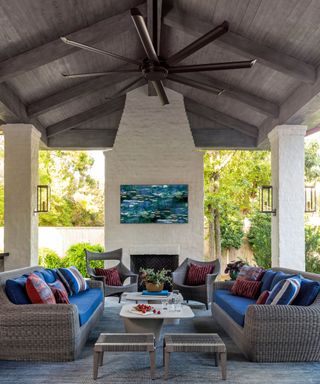
When designing an outdoor living room, choosing high-performance and outdoor-friendly fabrics and furniture is crucial for both aesthetics and longevity. Unlike indoor spaces, outdoor areas are exposed to the elements, requiring materials that can withstand varying weather conditions.
'High-performance fabrics were a must when designing this outdoor living space,' says Benjamin Johnston, founder of Benjamin Johnston Design and creator of the space above. 'An oversized fan ensures you stay cool during those Texas summers and plenty of areas to lounge, including bar stools, make hosting easy. Make sure to include plenty of comforts when designing an outdoor living room, and accommodate for your climate – if you know it will get hot make sure there are shaded areas or a fan. Also, bring in an oversized area rug to really up the cozy factor and tie together design elements,' he advises.
Opt for furniture made from materials like teak, aluminum, or all-weather wicker, which are designed to endure sun, rain, and even snow. Equally important is the selection of fabrics that are resistant to fading, moisture, and mildew. Performance fabrics like solution-dyed acrylics and polyesters are specifically engineered for outdoor use, ensuring that your cushions and upholstery remain vibrant and fresh season after season.
11. Focus on lighting for ambiance
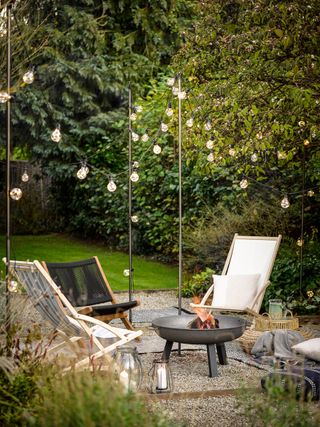
Choosing, organizing, and positioning backyard lighting ideas to create a relaxing outdoor living space can be daunting, so take your time in the planning and consider the outdoor space as a whole.
Before you even start to think about pretty twinkling string lights or dramatic accent spotlights, decide if you’re going to use solar lighting, electric lighting (in which case you’ll need the help of a suitably qualified electrician), or a combination of both.
Follow the same lighting mantra you would indoors: task lighting for specific activities, so this might include lighting the garden path ideas to your outdoor living area or highlighting particular features.
'Position lights within ingresses, sleepers, or garden borders so you see the effect of the light, rather than the light itself,' says Kate Baker, lighting design advisor at smart lighting experts 4lite.
12. Create areas designed for entertainment

These year-round structures offer smart spaces for garden bar ideas and are also perfect for incorporating homey touches to really enhance the living room feel, allowing you to have all the mod-cons you would expect in an indoor space.
Think lighting, heating, speakers, a television, space for an outdoor kitchen or bar area, and built-in fireplace and storage niches.
Although these areas are sheltered, make sure to use outdoor-specific furniture and materials to prevent as much damage from winter weather and cold temperatures as possible.
13. Gather round a fireplace or firepit
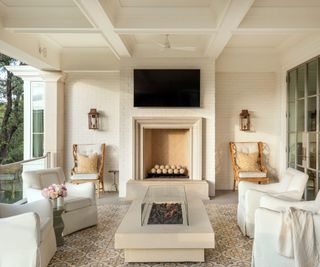
Striking outdoor fireplace ideas are the ultimate centerpiece for gathering around as the sun goes down. The layout of your outdoor furniture can help to inform which style you should look for. A chimenea is a great choice for directing heat to a specific area, like your favorite lounger.
'Seating wrapped around a firepit makes for a great arrangement to encourage conversation and the warmth from a firepit can offer amazing comfort and visual ambiance,' says Denise Morrison of Morrison Interiors. 'Incorporate weather-resistant materials for durability and add warmth and ambiance with an outdoor rug and throw pillows.'
Braziers and fire pits may provide less direct warmth but have the benefit of creating an atmosphere that can be enjoyed from all directions and are usually suitable for cooking on, too.
14. Provide a connection to your outdoor kitchen

Set up the perfect space this summer for gathering with friends and family by using comfortable furniture and incorporating areas for cooking and dining, too. The key to a successful outdoor living space is connectivity, when your outdoor kitchen and living room are well-integrated, it feels like an extension of your indoor space, promoting ease of movement and socializing.
Outdoor kitchens should be positioned close to the living area, but with enough space to allow for distinct activities without overlap. An island or bar with seating not only provides a spot for guests to gather but also acts as a bridge between cooking and lounging zones.
‘Don’t feel you have to stick to a garden set, here mixing and matching furniture adds character,’ says Sue Jones, Co-founder and Creative Director at OKA, who styled this space. If you're looking for small backyard ideas or wondering what to include on a balcony, it’s best to stick to the essentials: extra stools that serve as side tables, floor cushions, and a bistro table set are all good choices.
15. Finally, up the style stakes with accessories and decor
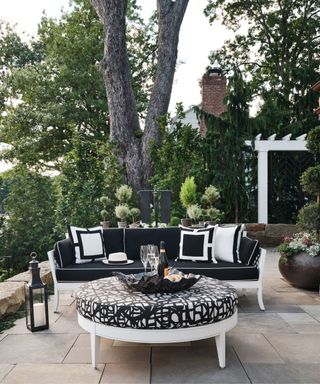
When considering decorating and styling an outdoor lounge area, make sure to give it as much thought as you would any interior room, in terms of both appearance and feel.
Enhance the comfort and coziness of the space further by ensuring you layer up soft furnishings and accessories. Throws and cushions can change color schemes with ease, while also making the space more inviting.
'Creating an outdoor living room involves selecting comfortable, weather-resistant furniture and incorporating elements like rugs, throw pillows, and lighting to enhance the cozy, indoor feel,' suggests Ginger Curtis of Urbanology Designs. 'Adding greenery and a focal point, such as a fire pit or water feature, can also elevate the space and make it inviting for relaxation and dining al fresco! '
Outdoor rugs heighten the ‘zoned’ feeling of the area, while adding another layer of comfort. Finish by lighting as you would indoors, with outdoor lighting ideas such as freestanding garden floor lamps, hurricane lamps, or even candles.
FAQs
How do I create an outdoor living room?
Use every opportunity to entertain al fresco style or just to enjoy living in your garden this summer. With furniture and accessories that don’t cost the earth, it is even easier than ever to create that outside room you’ve always dreamed of.
Before you buy anything too big and bulky, think about where you’ll store it out of season. Folding loungers take up less shed-space than fixed loungers, which can be bulky and awkward to manoeuvre, although they can often be stacked vertically.
Modular units are easy to take apart and can be stacked on top of each other in a shed or garage.
When it comes to cushions, make sure they’re detachable so you can take them off and store them away overnight or in bad weather, with zip-off covers that are easy to wash.
For poolside loungers, avoid cushions altogether and opt for textilene, a stretchy PVC mesh sling that is waterproof and dries off quickly. The surface is springy, making it ultra comfy to lie on.
How can I make my outdoor living space look bigger?
Embrace the space you have and follow this season’s ‘cozy garden’ trend by arranging your garden furniture in a circle, says garden designer Jo Thompson. 'Doing this will give a more embracing feel.'
Thinking of a modest yard as a living room will make the most of its limited proportions, so bring in throws and cushions to stress comfort over spacious proportions. You might think white walls and fences will make the space appear larger, but this choice can create a clinical space that works best in warmer climates. Choose earthy natural tones of soft terracotta and olive green instead.
Erika Woelfel, vice-president of color and creative services at Behr Paint Company likes Secret Meadow, a deep olive-ish green: 'It adds a sense of intrigue for guests about to enter your garden or backyard hideaway.'
How can I make my indoor and outdoor living space flow together?
Start with the flooring. If you have wooden floorboards indoors, lay decking in the same direction and choose a complementary shade for the deck-stain. Keep entryways between inside and outside clear of furniture and other items such as large plant-pots which make a statement but can create a visual blockage. If your outdoor space is accessed through a set of doors, it’s good if the threshold (the strip at the bottom of the frame) can be level, so there is no step between both indoors and outside.
When deciding on outdoor living furniture, take cues from the closest indoor room to the garden. Jonny Brierley, CEO at outdoor furniture specialists Moda Furnishings says that shades of gray remain a favorite choice here: 'The demand for gray homewares like sofas and kitchen furniture continues to dominate, so our customers want to echo this stylish look in their gardens.'
Sign up to the Homes & Gardens newsletter
Design expertise in your inbox – from inspiring decorating ideas and beautiful celebrity homes to practical gardening advice and shopping round-ups.

Jennifer is the Digital Editor at Homes & Gardens. Having worked in the interiors industry for a number of years, spanning many publications, she now hones her digital prowess on the 'best interiors website' in the world. Multi-skilled, Jennifer has worked in PR and marketing, and the occasional dabble in the social media, commercial and e-commerce space. Over the years, she has written about every area of the home, from compiling design houses from some of the best interior designers in the world to sourcing celebrity homes, reviewing appliances and even the odd news story or two.
- Charlotte OlbyStyle & Trends Editor
-
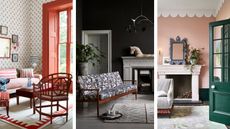 Can you wash a rug in the washer? Our rug cleaning experts reveal how to avoid damage
Can you wash a rug in the washer? Our rug cleaning experts reveal how to avoid damageFrom best materials to cycle settings, our panel of experts share their advice
By Andy van Terheyden Published
-
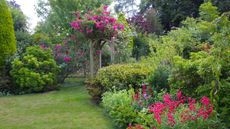 11 plants to propagate in winter – we show how simple it is to get more of your best-loved shrubs from cuttings
11 plants to propagate in winter – we show how simple it is to get more of your best-loved shrubs from cuttingsWhy not start propagating in winter and get more plants for free? It can be done with hardwood cuttings from these popular shrubs
By Drew Swainston Published